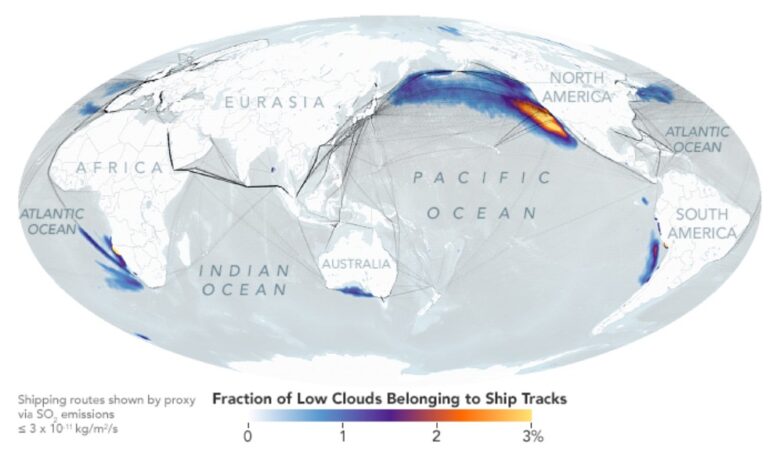NASA hails global sulphur cap a success

NASA has hailed the beneficial effects of the global sulphur cap to the atmosphere. A newly published study from the American space agency has found that so-called ship track clouds dropped dramatically in 2020, the first year of the implementation of the International Maritime Organization’s new fuel regulations. NASA conceded that pandemic-related disruptions played a secondary, smaller role in the decline of shipping pollution that year.
Ship tracks, the polluted marine clouds that trail ocean-crossing vessels, are a signature of modern trade, described by NASA as “ghostly fingerprints” tracing shipping lanes around the globe. Ship tracks are formed by water vapour coalescing around small particles of pollution – aerosols – in ship exhaust. The highly concentrated droplets scatter more light and therefore appear brighter than non-polluted marine clouds, which are seeded by larger particles such as sea salt.
Drawing on nearly two decades of satellite imagery, researchers found that the number of ship tracks fell significantly after the global sulphur cap – also known as IMO 2020 – went into effect. The cap required an 86% reduction in fuel sulphur content which NASA believes reduced ship track formation. By capping fuel sulphur content at 0.5% , down from 3.5%, IMO’s global regulation in 2020 changed the chemical and physical composition of ship exhaust.
Scientists used advanced computing techniques to create the first global climatology of ship tracks. They used artificial intelligence to automatically identify ship tracks across 17 years of daytime images captured by NASA’s Moderate Resolution Imaging Spectroradiometer (MODIS) aboard the Aqua satellite.
“Without this kind of complete and large-scale sampling of ship tracks, we cannot begin to completely understand this problem,” said lead author Tianle Yuan, an atmospheric scientist at NASA’s Goddard Space Flight Center in Greenbelt, Maryland, and the University of Maryland, Baltimore County.
According to Yuan and colleagues, similar but regionally defined sulphur regulations – such as an emission control area in effect since 2015 off the west coast of the US and Canada – had not had the desired effect because operators altered their routes and charted longer courses to avoid designated zones.
While analysing 2020 data, the researchers found that ship-track density fell that year in every major shipping lane. Ship-based tracking data indicated that the covid pandemic played a role by decreasing global shipping traffic by 1.4% for a few months. But this change alone could not explain the large decrease in observed ship tracks, which remained at record-low levels through several months of 2021, the most recent data analysed.
How IMO’s next green regulations – CII and EEXI – slash emissions further will also likely be tracked by NASA satellites.
